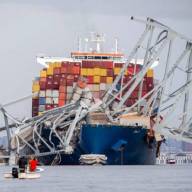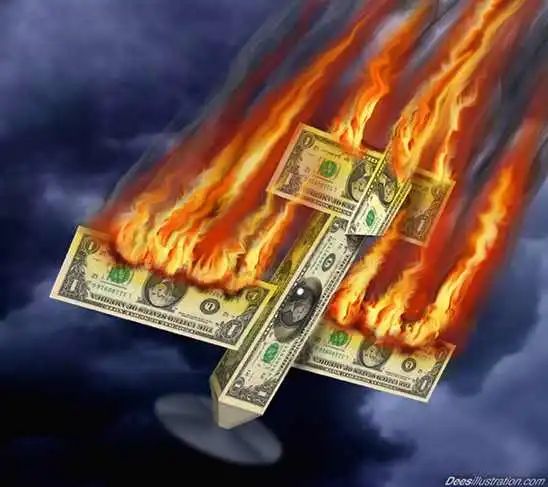One of the curious features of the American landscape is the fact that these days the financialization of the economy is widely condemned as unhealthy, yet little is being done to reverse it.
There was a time, back in the 1980s and ‘90s, when finance-driven capitalism was supposed to usher in a time of better capital allocation and a more dynamic economy. This is not a view one hears often anymore.
So, if such a phenomenon is overwhelmingly viewed negatively but isn’t being amended, then perhaps it’s not merely a failure of policymaking but rather something deeper – something more endemic to the very fabric of the capitalist economy. It is of course possible to lay the blame for this state of affairs at the feet of the current crop of cynical and power-hungry elites and to stop one’s analysis there. But an examination of history reveals recurrent instances of financialization that bear remarkable similarities, which invites the conclusion that perhaps the predicament in the American economy in recent decades is not unique and that the ever-rising power of Wall Street was in a sense preordained.
Introducing Giovanni Arrighi: Financialization as a cyclical phenomenon
It is in this context that it pays to revisit the work of the Italian political economist and historian of global capitalism Giovanni Arrighi (1937-2009). Arrighi, who is often simplistically pigeonholed as a Marxist historian, a label far too constricting given the breadth of his work, explored the origins and evolution of capitalist systems dating back to the Renaissance and showed how recurrent phases of financial expansion and collapse underpin broader geopolitical reconfigurations. Occupying a central place in his theory is the notion that the cycle of rise and fall of each successive hegemon terminates in a crisis of financialization. It is this phase of financialization that facilitates the shift to the next hegemon.
Arrighi dates the origin of this cyclical process to the Italian city-states of the 14th century, an era that he calls the birth of the modern world. From the marriage of Genoese capital and Spanish power that produced the great discoveries, he traces this path through Amsterdam, London and, finally, the United States.
In each case, the cycle is shorter and each new hegemon is larger, more complex and more powerful than the previous one. And, as we mentioned above, each terminates in a crisis of financialization that marks the final stage of hegemony. But this phase also fertilizes the soil in which the next hegemon will sprout, thus marking financialization as the harbinger of an impending hegemonic shift. Essentially, the ascending power emerges in part by availing itself of the financial resources of the financialized and declining power.
Hegemony he defines as “the power of a state to exercise functions of leadership and governance over a system of sovereign states.” Central to this concept is the idea that historically such governance has been linked to the transformation of how the system of relations among states functions in itself and also that it consists of both what we would call geopolitical dominance but also a sort of intellectual and moral leadership. The hegemonic power not only rises to the top in the jockeying among states but actually forges the system itself in its own interest. Key to this capacity for the expansion of the hegemon’s own power is the ability to turn its national interests into international interests.
Observers of the current American hegemony will recognize the transformation of the global system to suit American interests. The maintenance of an ideologically charged ‘rules-based’ order – ostensibly for the benefit of everyone – fits neatly into the category of conflation of national and international interests. Meanwhile, the previous hegemon, the British, had their own version that incorporated both free-trade policies and a matching ideology that emphasized the wealth of nations over national sovereignty.
Returning to the question of financialization, the original insight into its epochal aspect first came from the French historian Fernand Braudel, of whom Arrighi was a disciple. Braudel observed that the rise of finance as the predominant capitalist activity of a given society was a sign of its impending decline.
Arrighi adopted this approach and, in his major work called ‘The Long Twentieth Century,’ elaborated his theory of the cyclical pattern of ascendency and collapse within the capitalist system, which he called the ‘systemic cycle of accumulation.’ According to this theory, the period of ascendency is based on an expansion of trade and production. But this phase eventually reaches maturity, at which point it becomes more difficult to profitably reinvest capital in further expansion. In other words, the economic endeavors that propelled the rising power to its perch become increasingly less profitable as competition intensifies and, in many cases, much of the real economy is lost to the periphery, where wages are lower. Rising administrative expenses and the cost of maintaining an ever-expanding military also contribute to this.
This leads to the onset of what Arrighi calls a ‘signal crisis,’ meaning an economic crisis that signals the shift from accumulation by material expansion to accumulation by financial expansion. What ensues is a phase characterized by financial intermediation and speculation. Another way to think about this is that, having lost the actual basis for its economic prosperity, a nation turns to finance as the final economic field in which hegemony can be sustained. The phase of financialization is thus characterized by an exaggerated emphasis on financial markets and the finance sector.
How financialization delays the inevitable
However, the corrosive nature of financialization is not immediately evident – in fact, quite the opposite. Arrighi demonstrates how the turn to financialization, which is initially quite lucrative, can provide a temporary and illusory respite from the trajectory of decline, thus deferring the onset of the terminal crisis. For example, the incumbent hegemon at the time, Great Britain, was the country hardest hit by the so-called Long Depression of 1873-1896, a prolonged period of malaise that saw Britain’s industrial growth decelerate and its economic standing diminished. Arrighi identifies this as the ‘signal crisis’ – the point in the cycle where productive vigor is lost and financialization sets in.
And yet, as Arrighi quotes David Landes’ 1969 book ‘The Unbound Prometheus,’ “as if by magic, the wheel turned.” In the last years of the century, business suddenly improved and profits rose. “Confidence returned—not the spotty, evanescent confidence of the brief booms that had punctuated the gloom of the preceding decades, but a general euphoria such as had not prevailed since…the early 1870s….In all of western Europe, these years live on in memory as the good old days—the Edwardian era, la belle époque.” Everything seemed right again.
However, there is nothing magical about the sudden restoration of profits, Arrighi explains. What happened is that “as its industrial supremacy waned, its finance triumphed and its services as shipper, trader, insurance broker and intermediary in the world’s system of payments became more indispensable than ever.”
In other words, there was a large expansion in financial speculation. Initially much of the expanding financial income derived from interest and dividends being generated by previous investments. But increasingly a significant portion was financed by what Arrighi calls the “domestic conversion of commodity capital into money capital.” Meanwhile, as surplus capital moved out of trade and production, British real wages began a decline starting after the mid-1890s – a reversal of the trend of the past five decades. An enriched financial and business elite amid an overall decline in real wages is something that should ring a bell to observers of the current American economy.
Essentially, by embracing financialization, Britain played the last card it had to stave off its imperial decline. Beyond that lay the ruin of World War I and the subsequent instability of the interwar period, a manifestation of what Arrighi calls ‘systemic chaos’ – a phenomenon that becomes particularly visible during signal crises and terminal crises.
Historically, Arrighi observes, these breakdowns have been associated with escalation into outright warfare – specifically, the Thirty Years’ War (1618-48), the Napoleonic wars (1803-15) and the two World Wars. Interestingly and somewhat counterintuitively, these wars have typically not seen the incumbent hegemon and the challenger on opposing sides (with the Anglo-Dutch naval wars a notable exception). Rather, it has typically been the actions of other rivals that have hastened the arrival of the terminal crisis. But even in the case of the Dutch and British, conflict co-existed with cooperation as Dutch merchants increasingly directed their capital to London, where it generated better returns.
Wall Street and the crisis of the last hegemon
The process of financialization emerging from a signal crisis was repeated with startling similarities in the case of Britain’s successor, the US. The 1970s was a decade of deep crisis for the US, with high levels of inflation, a weakening dollar after the 1971 abandonment of gold convertibility and, perhaps most importantly, a loss of competitiveness of US manufacturing. With rising powers such as Germany, Japan, and, later, China, able to outcompete it in terms of production, the US reached the same tipping point and, like its predecessors, it turned to financialization. The 1970s was, in the words of historian Judith Stein, the “pivotal decade” that “sealed a society-wide transition from industry to finance, factory floor to trading floor.”
This, Arrighi explains, allowed the US to attract massive amounts of capital and move toward a model of deficit financing – an increasing indebtedness of the US economy and state to the rest of the world. But financialization also allowed the US to reflate its economic and political power in the world, particularly as the dollar was ensconced as the global reserve currency. This reprieve gave the US the illusion of prosperity of the late 1980s and ‘90s, when, as Arrighi says “there was this idea that the United States had ‘come back’.” No doubt the demise of its main geopolitical rival, the Soviet Union, contributed to this buoyant optimism and sense that Western neoliberalism had been vindicated.
However, beneath the surface, the tectonic plates of decline were still grinding away as the US became ever more dependent on external funding and increasingly ramped-up leverage on a diminishing sliver of real economic activity that was rapidly being offshored and hollowed out. As Wall Street rose in prominence, many quintessential American economies were essentially asset-stripped for the sake of financial profit.
But, as Arrighi points out, financialization merely stalls the inevitable and this has only been laid bare by subsequent events in the US. By the late 1990s, the financialization itself was beginning to malfunction, starting with the Asia crisis of 1997 and subsequent popping of the dotcom bubble, and continuing with a reduction in interest rates that would inflate the housing bubble that detonated so spectacularly in 2008. Since then, the cascade of imbalances in the financial system has only accelerated and it has only been through a combination of increasingly desperate financial legerdemain – inflating one bubble after another – and outright coercion that has allowed the US to extend its hegemony even a bit longer beyond its time.
In 1999, Arrighi, in a piece co-authored with American scholar Beverly Silver, summarized the predicament of the time. It has been a quarter century since these words were penned, but they might as well have been written last week:
“The global financial expansion of the last twenty years or so is neither a new stage of world capitalism nor the harbinger of a ‘coming hegemony of global markets’. Rather, it is the clearest sign that we are in the midst of a hegemonic crisis. As such, the expansion can be expected to be a temporary phenomenon that will end more or less catastrophically… But the blindness that led the ruling groups of [hegemonic states of the past] to mistake the ‘autumn’ for a new ‘spring’ of their…power meant that the end came sooner and more catastrophically than it might otherwise have…A similar blindness is evident today.”
An early prophet of a multipolar world
In his late work, Arrighi turned his attention to East Asia and surveyed the prospects for a transition to the next hegemony. On the one hand, he identified China as the logical successor to American hegemony. However, as a counterweight to that, he did not see the cycle he outlined as continuing in perpetuity and believed there would come a point where it is no longer possible to bring into existence a state with larger and more comprehensive organizational structures. Perhaps, he speculated, the US represents just that expansive capitalist power that has taken the capitalist logic to its earthly limits.
Arrighi also considered the systemic cycle of accumulation to be a phenomenon inherent to capitalism and not applicable to pre-capitalist times or non-capitalist formations. As of 2009, when he died, Arrighi’s view was that China remained a decisively non-capitalist market society. How it would evolve remained an open question.
While Arrighi was not dogmatic on how the future would shape up and did not apply his theories deterministically, especially with regard to the developments of recent decades, he did speak forcefully about what in today’s language could be called the necessity of accommodating a multipolar world. In their 1999 article, he and Silver predicted “a more or less imminent fall of the West from the commanding heights of the world capitalist system is possible, even likely.”
The US, they believe, “has even greater capabilities than Britain did a century ago to convert its declining hegemony into an exploitative dominion.” If the system does eventually break down, “it will be primarily because of US resistance to adjustment and accommodation. And conversely, US adjustment and accommodation to the rising economic power of the East Asian region is an essential condition for a non-catastrophic transition to a new world order.”
Whether such accommodation is forthcoming remains to be seen, but Arrighi strikes a pessimistic tone, noting that each hegemon, at the end of its cycle of dominance, experiences a “final boom” during which it pursues its “national interest without regard for system-level problems that require system-level solutions.” A more apt description of the current state of affairs cannot be formulated.
The system-level problems are multiplying, but the sclerotic ancien régime in Washington is not addressing them. By mistaking its financialized economy for a vigorous one, it overestimated the potency of weaponizing the financial system it controls, thus again seeing ‘spring’ where there is only ‘autumn.’ This, as Arrighi, predicts, will only hasten the end.
Author
Henry Johnston, an RT editor. He worked for over a decade in finance and is a FINRA Series 7 and Series 24 license holder.



















